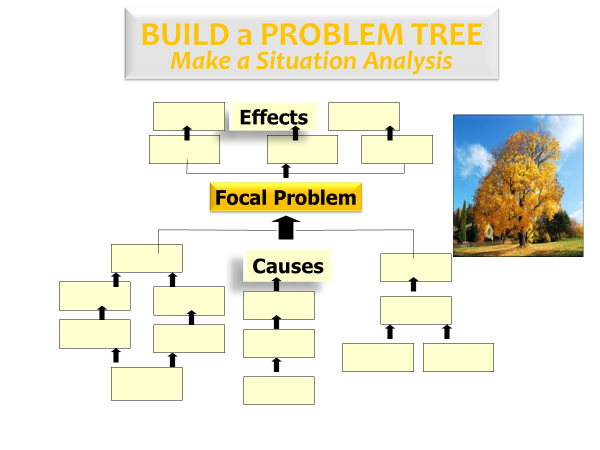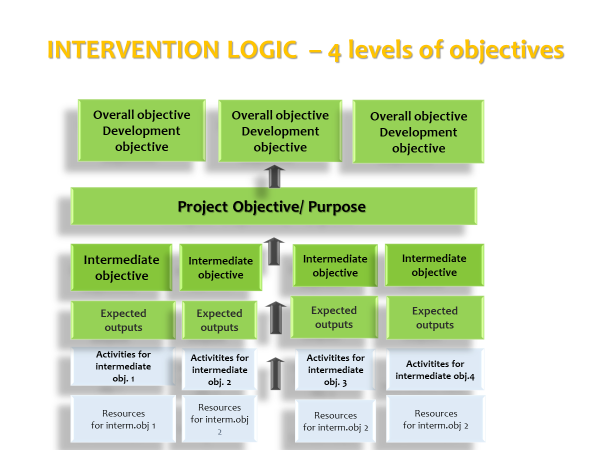PROJECT DESIGN Ltd Ms Kari Örtengren
INFORMATION ON THE CONSULTANT
Company: Project Design Ltd.
Consultant: Ms. Kari Örtengren
Project Design’s consultant, Kari Örtengren, has an exceptional broad experience on efficient and sustainable project/program- and business planning, management and quality assessment. The consultant, Kari Örtengren, has worked with international development co-operation since 1988, both from the perspective as a financier, as a regional manager and as a consultant with development of projects, implementation and monitoring, advisor to project groups. She is an well- known expert on Project Cycle Management (PCM), the Logical Framework Approach (the LFA-method) as well as Results-Based Management (RBM) with 30 years of a experience in assessing, developing/planning, implementing programmes/projects as well as evaluation according to the LFA-method and to RBM.
The consultant, Kari Örtengren, is professionally trained and a certified facilitator of inter-active project planning and monitoring techniques according to the Logical Framework Approach (LFA). She is trained by the PCM Group/Brussels and trained as trainer and coach. By having worked for over 20 years with the LFA method and planned, facilitated and reported/monitored over 350 workshops in 50 countries in Europe, Africa, Asia and Latin America, in a broad range of sectors.
The consultant has a long pedagogical experience after having planned, performed and monitored more than 400 training seminars, most often in project and programme planning and project assessment techniques and monitoring according to the LFA-method, RBM and PCM (Project Cycle Management. Participants at the seminars have in evaluations given a very positive response to the trainings, ranking between 4,5-4,9 on a scale 1-5 (where 5 is high).
The assignments have included several different sectors and stakeholders, the public sector with ministries and the civil society, from NGOs supporting disabled children to engineers working in the industrial waste management sector. A bulk of the projects has been in the field of human rights, environmental protection, gender equality, social well fare and capacity building, European integration, decentralisation and good governance. The projects and programme have been in Europe, Africa, Asia and Latin America. The project’s and programmes have been aiming at e.g. improving human rights, including gender equality, social well fare, more efficient division of functions and responsibilities, including law amendments, improved services in form of capacity building.
The seminars and workshops have, with very good results, often been conducted in different languages and different stakeholder groups with the assistance of interpreters. The consultant makes sure that training material always is translated into the local language, if needed.
THE LFA-METHOD and RBM (Results-Based Management)
A BRIEF INFORMATION ON THE LFA-METHOD by KARI ÖRTENGREN, LFA A RESULT-BASED PROJECT PLANNING METHOD
The consultant Kari Örtengren is frequently using the LFA- method, The Logical Framework Approach. LFA, is one of the methods used in Results-Based Management (RBM). LFA is a structured planning tool which is setting the basis for a good planning process and effective monitoring and evaluation of projects and programs. LFA has been used in thousands of projects in different sectors all over the world. The method may be used when planning projects and when making strategies in any sector. The tool is based on a participatory approach, hence, actively involving relevant and important stakeholders, including the beneficiaries, in the planning procedure. The LFA-method is one of the tools which may be used in Results-Based Management (RBM). RBM is a result-oriented mind-set on how to handle the whole project cycle or business cycle – planning, implementing and monitoring and evaluating. RBM is giving guidance on WHAT to do, but not exactly HOW. LFA is the HOW tool.
A basic idea with the LFA-method is that a project management group should not start by talking about what one wants to do (the activities, e.g. having a training or building a clinic etc.), but about what one wants to achieve/the results, which the problems are to be handled. In order to find the objectives and later the relevant solutions (activities), one needs to start by making a problem analysis together with relevant stakeholders, a listening process. This process starts with having the group identify the focal problem (Why is a change/ a project needed?) and then identify the causes and the effects to the selected main problem e.g. little awareness among the public on safe and healthy maternity.
The project planning procedure according to LFA contains nine different steps. The steps all together assist a project group to formulate a relevant, feasible and sustainable project. In brief the planning steps are:

Step 1: A CONTEXT ANALYSIS / BACKGROUND INFORMATION: All projects are part of a wider context, such as the political and economic situation in a country. It is important to analyze in which environment the project is situated. What external factors are important for the fulfillment of a future project’s objectives? Normally, this step is made through collecting data in studies either from the internet or by making specific studies (sector- or country studies). Often existing data/information exists on a sector, then a new study is unnecessary, it is just for the project group to collect the existing information.
Step 2: A STAKEHOLDER ANALYSIS: Stakeholders are people influenced by and exerting an influence on the things that take place in the project –directly or indirectly. Used correctly, the LFA-method is a very democratic tool. To reach good results, the project group should, in a participatory approach, collect and disseminate information from and to stakeholders prior to project start and during the implementation of the project. Involvement could be done through interviews and/ or workshops. An initial stakeholder analysis is made when inviting people to a planning LFA workshop or before making interviews, later a revised stakeholder analysis is made during the workshop or interviews, to check and see if all important stakeholders have been involved, if different points of views are taken into account.
When planning, the stakeholders for projects are divided into five main groups: the target group (including the beneficiaries), the implementers, the decisions makers, financing authorities/agencies and experts in the sector (such as researchers). Participants from these different groups should be involved, listened to, in the planning and implementation process.
Step 3: A PROBLEM ANALYSIS / SITUATION ANALYSIS: The problem analysis is preferably made during a workshop with a broad group of stakeholders from different groups invited to analyze the situation. The main problem (the focal problem) and the causes to that problem and its’ effects are analyzed. A so called “problem tree” is formed by note pads on a big wall to be able to visualize the situation. During a LFA workshop each stakeholder/participant independently writes notes, causes and effects to the main problem. A main problem could for instance be weak quality on health care service to young people in the region.

The problem analysis is needed to be able to develop relevant objectives and activities. The project’s activities shall aim at eliminating the causes to the main problem. The project group should try to solve as many causes (problems) as possible, preferably all of them, if possible. Without a problem analysis it will become very complicated, if even possible, to set relevant objectives for the project or the strategic plan and to find the right sustainable solutions to the problems. The problem analysis has to be made by the owners of the problem, different local stakeholders, not by external consultants and/or by financing agencies.
Step 4: THE OBJECTIVE ANALYSIS: When the problems, that the project shall contribute to eliminate have been identified, it is possible to identify the project’s objectives. An objective analysis makes clear: Why the change/project is important and why the project is needed. The initial objective analysis is often made during a LFA workshop, the workshop participants then give proposals on objectives, proposals which are later handed over to a project group/management group. It is up to the project group to decide what the project’s final objectives will be.
There are four levels of objectives:

A project has several overall objectives and several intermediate objectives, but should preferably only have one project objective (main aim, purpose). The different levels of objectives are interlinked and directly linked to the problem analysis. The problem analysis is of great support to make us identifying relevant objectives. The project and intermediate objectives should be “SMART” (Specific, Measurable, Accurate, Realistic and Time-bound). The activities should always be connected to the intermediate objectives.
There is actually even a fourth level of objective which is called expected outputs. An output is a very direct consequence of an activity, such as after the activity arranging a maternity health care training, the output could be e.g. 200 nurses trained in maternity health care. Another example, after an activity publishing an information booklet, the output could e.g. be 2 500 booklets on food safety translated and published and distributed to 5 regions. Hence, each activity leads to an output. The expected outputs may not be developed until after the plan of activity /strategy is made. Hence, the outputs are not deriving from the problem analysis, but from the activities. The outputs have a clear connection to the budgeting process and time line, for example there is a big difference in the budget to publish 20 booklets or to publish 20.000 booklets.
Step 5: A PLAN of ACTIVITIES (STRATEGY): It is the causes of the focal problem that shall be “tackled” through activities. The activity plan should consist of the activities suitable for solving the causes of the main problem. The activities are means to achieve the objective, directly the short-term objectives. A brain storming of activities is usually made during an initial workshop. Later a designated project management group, makes a more detailed project plan based on the problem analysis, objectives and proposals of activities made during the initial LFA workshop. Naturally, some activities may be changed during implementation, if needed- adaptive management.
Step 6: A PLAN OF RESOURCES: Further, the project group takes the responsibility to make a plan of resources, needed for implementation of the activities in the project. The resource planning can’t be made until after the activities are planned. Resources are e.g. personnel/staff, financing/budget, time (time-schedule), and if needed, premises and equipment.
Step 7: INDICATORS and MEANS of VERIFICATIONS: Indicators are measurements of the progress of a project. Indicators are set for the objectives, on the short-term objectives (to each intermediate objectives) and on the project objective. The designated project group is identifying the indicators and means of verifications (MoVs), means to analyze the indicators such as through questionnaires, tests, studies, interviews with the target group etc. The indicators are monitored continuously through the implementation of the project.
Examples on indicators for the intermediate objective:

Step 8: A RISK ANALYSIS and RISK MANAGEMENT PLAN: Risk analysis is an identification of risk factors affecting the achievement of different objectives with a project. An initial risk analysis could be made during a LFA workshop. The risks are divided into internal and external risks. The internal risks, are risks, which the project group may exercise control over. A typical internal risk in most projects is brain-drain (loosing trained staff) or another risk could be difficulties to deliver medicine in remote villages. The external risks are risks, which exist outside the framework of the project, risks which the project group often may not control (e.g. the political situation in the country, weather conditions such as flooding or external corruption etc.).
After the risk analysis is made, the project group is making a detailed risk management plan, how to mitigate the effects of the risks identified in order to avoid that they influence the results of the project. The risk management process will include integration of new activities in the project in order to avoid the identified risks. A risk analysis and risk management mitigation should always be made continuously during the implementation of a project/program since new risks may occur.
Step 9: ANALYSIS OF THE ASSUMPTIONS: The assumptions are external factors the project group does not have a direct control over, but factors nonetheless essential for goal fulfillment, e.g. the political environment, higher level corruption, the weather etc. The project group cannot include everything in a project. Hence, they need to assume that other projects/activities factors handle these situations (causes to the focal problem). An assumption for a project may, for instance, be that the political situation will not be aggravated and have a negative effect on the project results, if this is a reasonable assumption. If this is not realistic, it is a risk, rather than an assumption, and it should be handled in the risk management plan (step 8 above) which implies that activities should be prepared in order to reduce the risk such as by involving/informing politicians from different parties on the importance of changes to be made in the society for instance with regard to Sexual Health and Reproductive Rights (SRHR) etc.
Steps 2-3, 4, 5 and 6 in the LFA-method (the problem analysis, the objectives, the stakeholder analysis, an initial plan of activity (strategy) and a risk analysis) are steps, which are normally, done during an LFA planning workshop.
An initial planning workshop is telling us WHY a project is needed (WHAT is the main problem and the causes to the problem and which effects do the problem have on the society). The analysis during the workshop tells us WHAT a project will achieve (the objectives with the project and the main activities. The designated project group is after or sometimes even during the workshop handling more specifically HOW the project will be implemented with assistance of the input they get from the stakeholders during the workshop. The project management group will after the workshop make the final detailed project planning with the input from the LFA workshop. A project group needs a project plan with SMART objective, well specified activities, a clear resource planning, indicators and sources of verifications, a risk mitigation plan and assumptions. If needed, a project plan may be revised during implementation, use an adaptive management approach. However, the better the planning process, the less the risk that the management team will need to make big changes in the plan during project implementation.
When the project implementation starts, the monitoring process can be initiated. Monitoring of results achievement will be made continuously through the indicators and the means of verifications such as interviews, tests and questionnaires. The monitoring terminology is different from the planning terms used, for terminology see the picture below.

For more information on the RBM and LFA-method, please, see my LFA guideline on www.sida.se, the link below.

